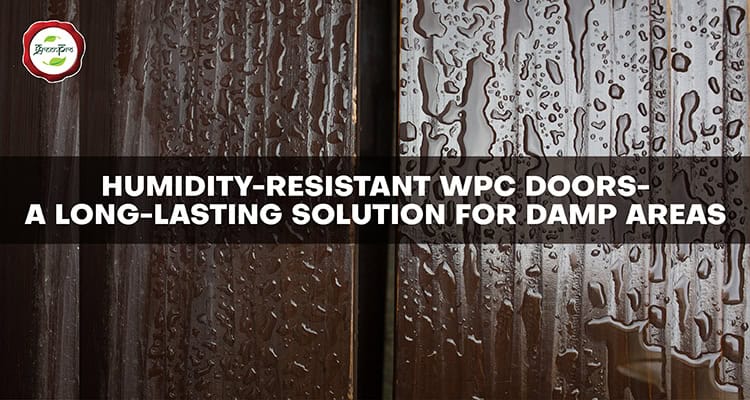In areas with constantly high humidity, there is a constant need for material that can withstand the perpetual onslaught of moisture. Wooden doors, though eye-catching in appearance, tend to warp, swell, or decay when placed in wet conditions. It is within this context that Wood Plastic Composite (WPC) doors are a game-changer. Let’s look at how WPC doors change the way people construct in damp areas.
The Humidity Issue
Before summarizing some of the benefits WPC doors has over other wooden door products, it is unavoidable to mention the issues that stem from excessive humidity conditions with some conventionally used materials are discussed below.
- Dimensional changes: Wood absorbs water and brings about dimensional changes
- Fungi growths: Conditions of condensed moisture facilitate heavy growth of fungi
- Rotting: Continuous exposure to moisture causes wood to rot
- Increased maintenance: Continuous humidity conditions encourage frequent maintenance of wooden parts.
And these issues not only compromise the aesthetic value of a space but also compromise structural integrity as well as air quality inside.
Enter WPC Doors: The Breath-of-Fresh-Air Natural Product
Wood Plastic Composite doors are, therefore, an excellent solution to humidity-related problems. Here’s why they outshine the rest in damp environments:
- Inherent Moisture Resistance
The plastic part of WPC shields it from moisture. In WPC, one does not get moisture absorbency like that in any conventional wood. It does not swell or warp due to high humidity. This feature maintains the shape and fit of doors for all seasons.
- Mold and Mildew Resistance
Since WPC does not absorb water, it resists mold and mildew growth. Moisture cannot penetrate through to rot the door’s surface, hence the door retains its appearance for more time. This helps in having a healthier interior area, especially in naturally damp areas.
- No Rotting
Unlike wood, WPC will not rot under moist exposure. It is instead adding years to the life of the door and is a great investment over the long haul, especially when using this in a highly humid climate.
- Low Maintenance Requirements
WPC doors have natural moisture-resistant properties that denote a condition of needing to be maintained less often than any wooden door that any person would view in a damp environment. In such a damp environment, anyone would appreciate not having to paint, seal, or treat the door as needed.
Uses in Different Damp Environments
WPC doors work in multiple moisture-related environments.
- Bathrooms and Kitchens: These high-internal-humidity zones are tolerant of the steam and fluctuating temperatures that WPC resists.
- Beach Homes: Salt spray and high moisture are no match for WPC’s durability.
- Basement Entries: WPC doors can easily tolerate moisture levels usually found at higher levels in below grade.
- Tropics and Sub-Tropical Climates: In regions where there is continuous high humidity, WPC doors stay intact and look fabulous.
- Pool Rooms and Saunas: The rooms which are perpetually exposed to water vapor, WPC is the best one.
Science Behind WPC’s Humidity Resistance
It isn’t coincidental that WPC doors perform flawlessly in high-moisture environments. It’s as a result of some meticulous engineering and material science:
Encapsulation: The plastic content fully encapsulates the wood fibers that prevent any entry of water vapour.
Density: The process of manufacture results in a dense material that doesn’t let water pass through it.
Chemical Treatments: Some WPC have further chemical treatments to enhance the resistance of water.
Long-Term Benefits of Installing WPC Doors in Wet Regions
WPC doors in wet regions come with a number of long term benefits:
- Cost-effective-Although it is fairly expensive than the regular wooden door, the durability and next to nothing maintenance associated with WPC door make it far more cost-efficient in the long run.
- Reliability-It retains functionality and looks over time, thus ensuring that your house or business is always on good terms.
- Energy Efficiency: The dimensional stability of WPC doors manages to maintain a better seal that will give a way to energy efficiency in heating and cooling.
- Environmental Considerations: A number of WPC doors is manufactured using recycled materials thus making these doors an ‘eco friendly option’ for aware consumers.
Installation and Maintenance Tips
To fully utilize the advantages of humidity-resistant WPC doors:
Ensure proper installation with sufficient weatherstripping in order to avoid water penetration.
Low maintenance. Periodic cleaning with mild soap and water helps maintain appearance
Hardware should be inspected annually and lubricated if necessary for preventing corrosion in humid conditions.
The Perfect, Long-Term Solution to Moist Problems:
WPC doors are a strong ally in the fight against moisture. They are low-moisture resistant, good structural strength, require minimal upkeep, and make them an excellent product for damp environments. You might be building a new home in paradise, or renovating a bathroom in a place with high humidity-that said, WPC doors associated with their functionality provide peace of mind with long-lasting solutions.
Indeed, by stepping on that journey of finding new solutions for climate-related problems, WPC doors are a giant step forward. They are covering not only practical issues related to living in such damp places but also result in sustainable, low-maintenance building practices. For homeowners and builders, the possibilities will open with WPC doors for creating durable, beautiful spaces that last as long as the weather decides.
